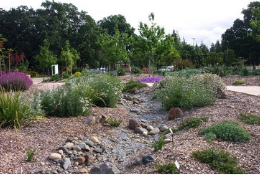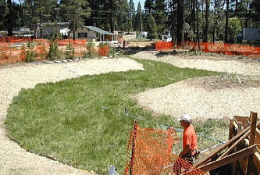Erosion control is a treatment that prevents or controls wind or water erosion in agriculture, construction, fire remediation, stormwater management, sustainable landscaping, and riparian and watershed restoration. USEPA lists sediment as the most common pollutant in water bodies, causing more than $16 billion in environmental damages annually.
Systems/treatments that use compost and mulch products significantly reduce erosion and protect our water bodies. Use systems/treatments on this page for erosion control.
Types of Systems and Treatments

A mesh tube filled with composted materials that landscapers place perpendicular to sheet-flow runoff to control erosion and retain sediment in disturbed areas. Depending on the particle size of the filter medium within the mesh tube, landscapers and contractors either use them to reduce heavy flows and trap sediment or to remove pollutants from urban runoff. Compost filter socks remove gasoline, diesel and oil residues from runoff. Filter socks, in 5”, 8” and 12” diameters, and are either purchased on pallets or made on site using the mesh and a blower truck.

A layer of loosely applied compost placed on the soil in disturbed areas to reduce storm water runoff and erosion. Typically applied using a blower truck, but could be applied by hand. The compost fills in small rills and voids to limit channelized flow, absorb water, and provide a more permeable surface to facilitate storm water infiltration. If rapid revegetation is the goal, gardeners can mix seeds into the compost before application.

Ground woody materials that protect relatively flat surfaces from wind and rain. Mulch absorbs some water, and as it breaks down gradually adds organic matter to the soil, increasing storm water infiltration and biological life. On steeper slopes, it may run off with sheet flow. Finely ground mulch can be blown into filter socks and used as a high-flow sediment trap. If used in this way, the mulch should be pathogen reduced first.

Biofiltration Strips and Swales
Biofiltration strips/vegetated buffer strips are vegetated sections of land over which stormwater moves as sheet flow (i.e., flow over plane surface where water spreads out at uniform depth). Biofiltration swales are vegetated channels that receive and direct the concentrated flow of stormwater.

Vertical spaces covered by live vegetation, also known as biowalls. Gardeners can use piles of seeded compost socks retained by wire mesh to create a retaining wall, which then grows plants. Placed along creeks to reduce bank erosion, along highways to keep sheet flow and sediments off the road, or in parks and other applications.

A manufactured soil consisting of specified ratios of sand, silt, clay, and organic amendments (e.g., compost) and designed for a specific application. Engineered soil is a permanent stormwater infiltration practice used to reduce stormwater runoff volume, sediments, and soluble pollutants from a watershed or drainage area.

Application of seed, fiber (such as compost), tackifier (to increase stickiness), and other materials such as fertilizer on disturbed soils with a hydraulic spray rig.
Resources
- Caltrans Erosion Control Toolbox
- University of Georgia Guidance on Compost Utilization for Erosion Control: Compost Utilization for Erosion Control
- Filtrexx Bank Stabilization Systems
- Compost Research & Education Foundation – Compost Specification Sheet for Erosion Control
Research
- Compost Demonstration Project, Placer County: Use of Compost as Primary Erosion Control Material
- A study funded by CalRecycle, Impact of Compost Application on Soil Erosion and Water Quality, demonstrated that compost can significantly reduce soil erosion:
- All compost treatments substantially reduced storm water runoff compared to the control by an overall average of 7.5 times (1.6 to 23.4 times).
- Compost use greatly reduced total suspended solids exports from the plots by an overall average of 39 times compared to the control on a mass flux basis.
- Compost treatments dramatically reduced total sediment losses, with an overall average of 57 times the controls’ flux values.
Resources
For more information contact: Organic Materials, organics@calrecycle.ca.gov

